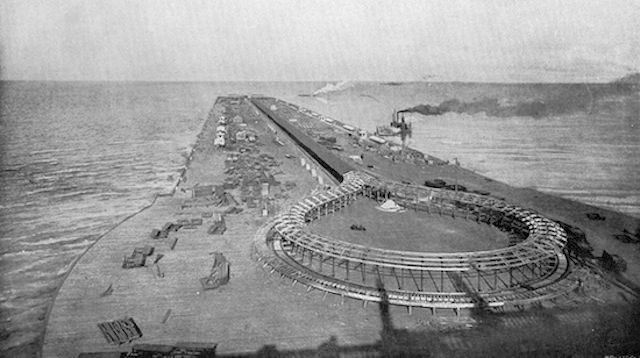How to Make a Subway Map with John Tauranac
Hear from an author and map designer who has been creating maps of the NYC subway, officially and unofficially, for over forty years!


Chicago’s moving sidewalk at the 1893 World’s Fair. Public domain photo via Wikimedia Commons from from the book “History of the World’s Fair” by Benjamin Cummings Truman and published by the Mammoth Publishing Company in 1893.
Before moving airport walkways, escalators and the High Line, there was a speeding (10 mph) sidewalk that ferried passengers high above Broadway–or there could have been, had it not been for a governor’s veto. In the late 1860s and early 1870s, elevated train lines were just opening around Manhattan. (The subway system didn’t run until 1900). But most of these tracks ran north of 14th Street, as downtown business owners fought to stick with the older streetcars. The result was an increase in street traffic in the area, with pedestrians and drivers fighting for space. To remedy the congestion near his store on Broadway near City Hall, inventor and wine seller Alfred Speer proposed a radical solution.
In 1871, Speer patented an elevated moving sidewalk (profiled in Scientific American a year later) which he called the “Endless Traveling or Railway Sidewalk.” Speer thought the thoroughfare could be used in crowded cities like New York, specifically up and down Broadway. Pedestrians would step up to a platform where they could pay their five-cent fare and get into a car that would transport them to a giant conveyor belt that looped high above the street. The 16-to-18-foot-wide path would be dotted with drawing rooms and smoking rooms for women and men, respectively, to relax and seek respite from bad weather. The entire system would be supported by iron pillars placed on the edges of each street, with the edge of the elevated sidewalk at least 12 feet away from the street-side buildings.
The sidewalk was pulled by moving cables up to speeds of 10 mph (more than double the supposed speed of a pedestrian, at 4 mph). Speer accommodated those who preferred not to walk, too. The sidewalk would also offer moving chairs for passengers to travel while seated. Unlike the elevated trains, which polluted the air with smoke and grease, the steam-powered sidewalks were environmentally friendly. In total, the sidewalk would have cost $3,722,400.
Speer’s plan gained support from prominent politician Horace Greeley and was passed by the state legislature in 1873 and 1874. But Governor John Dix ultimately vetoed the plan twice, objecting to the moving sidewalks’ interference with street-level sidewalks, the price tag and its layout (Speer’s sidewalk would have run up and down Broadway one time too many for Dix).
Unlike many other lofty proposals, the moving sidewalk was eventually realized, though not elevated above city streets. The first moving walkway debuted at Chicago’s World’s Fair in 1893, and a version was also used at the 1900 World’s Fair in Paris. New York didn’t completely abandon Speer’s idea, as the city used moving sidewalks when it hosted the 1964 World’s Fair. Finally, it seems one of New York’s ambitious inventors had a realistic plan that his contemporaries failed to see.
See more from our NYC That Never Was series. Get in touch with the author @catku.
Subscribe to our newsletter